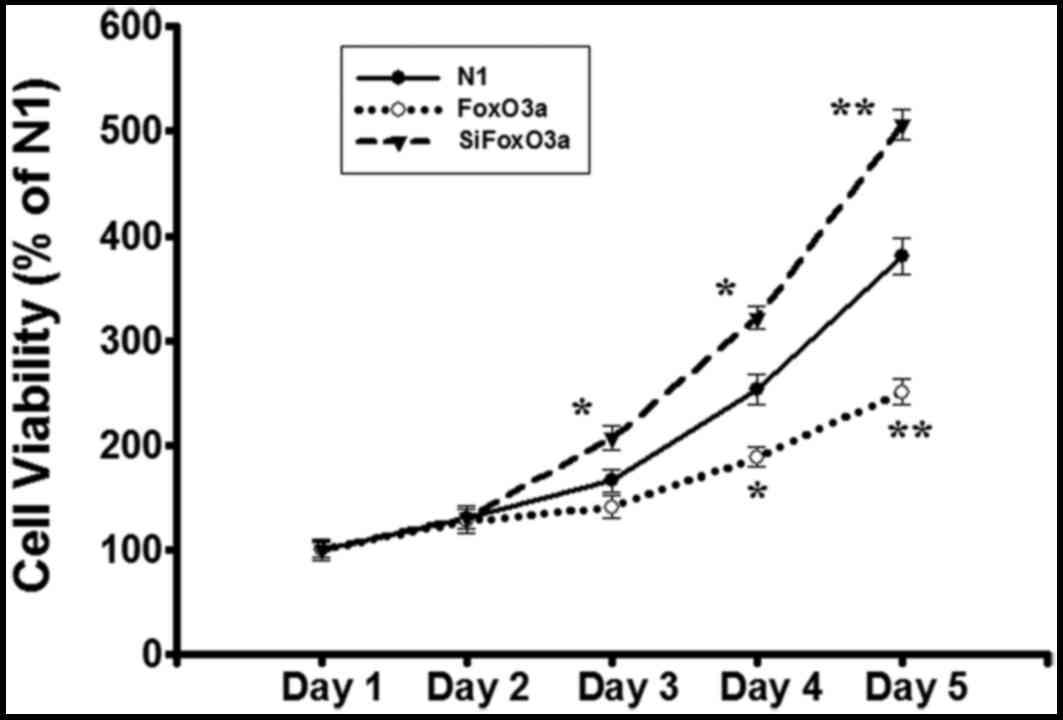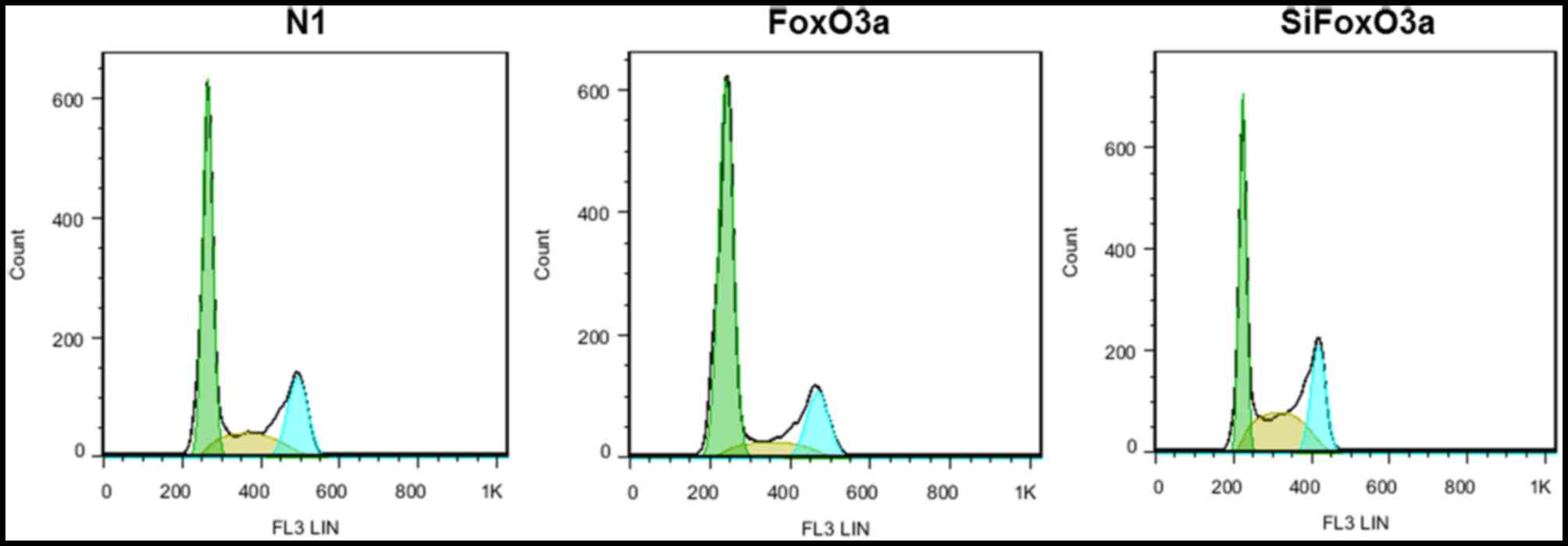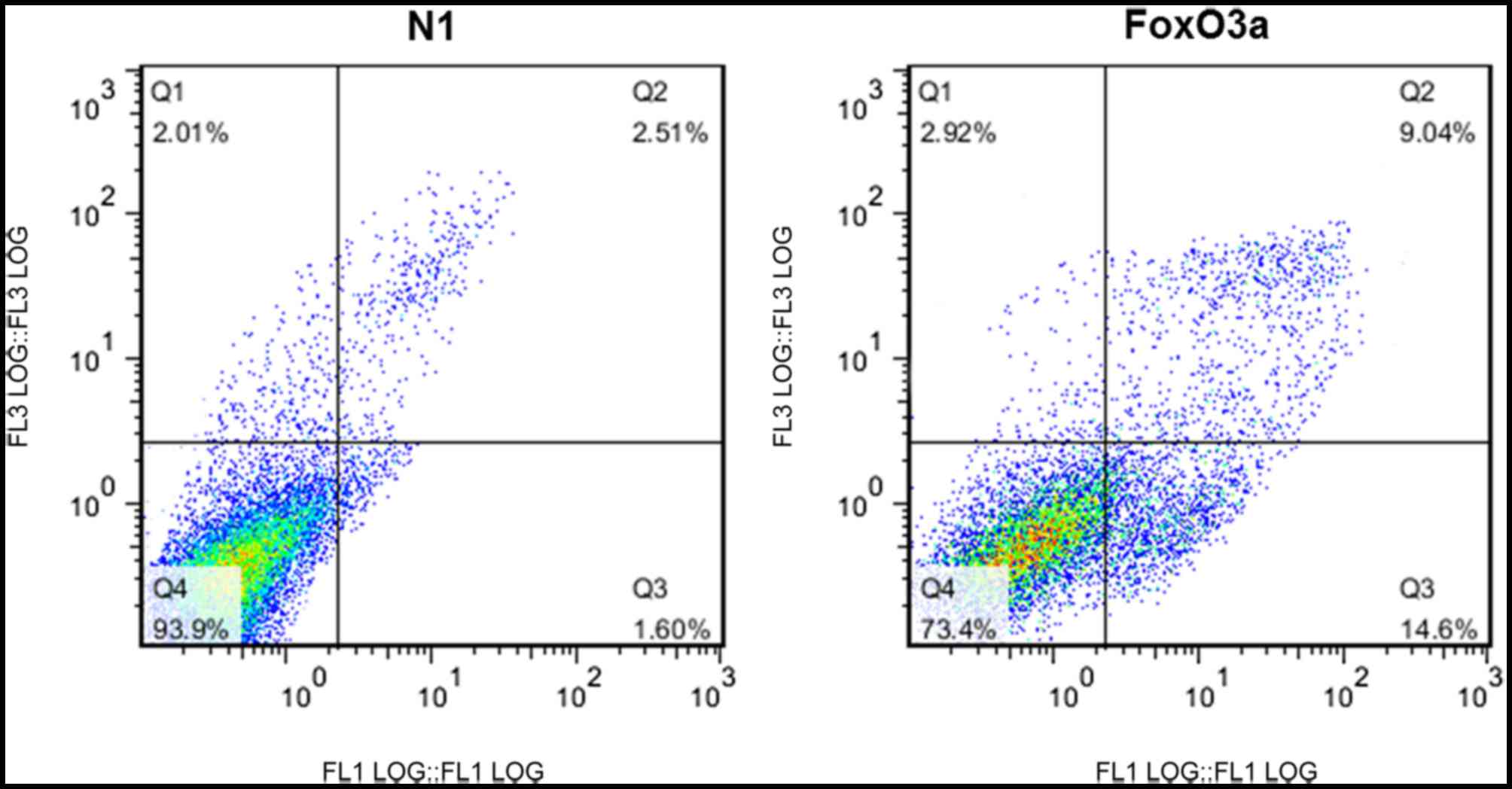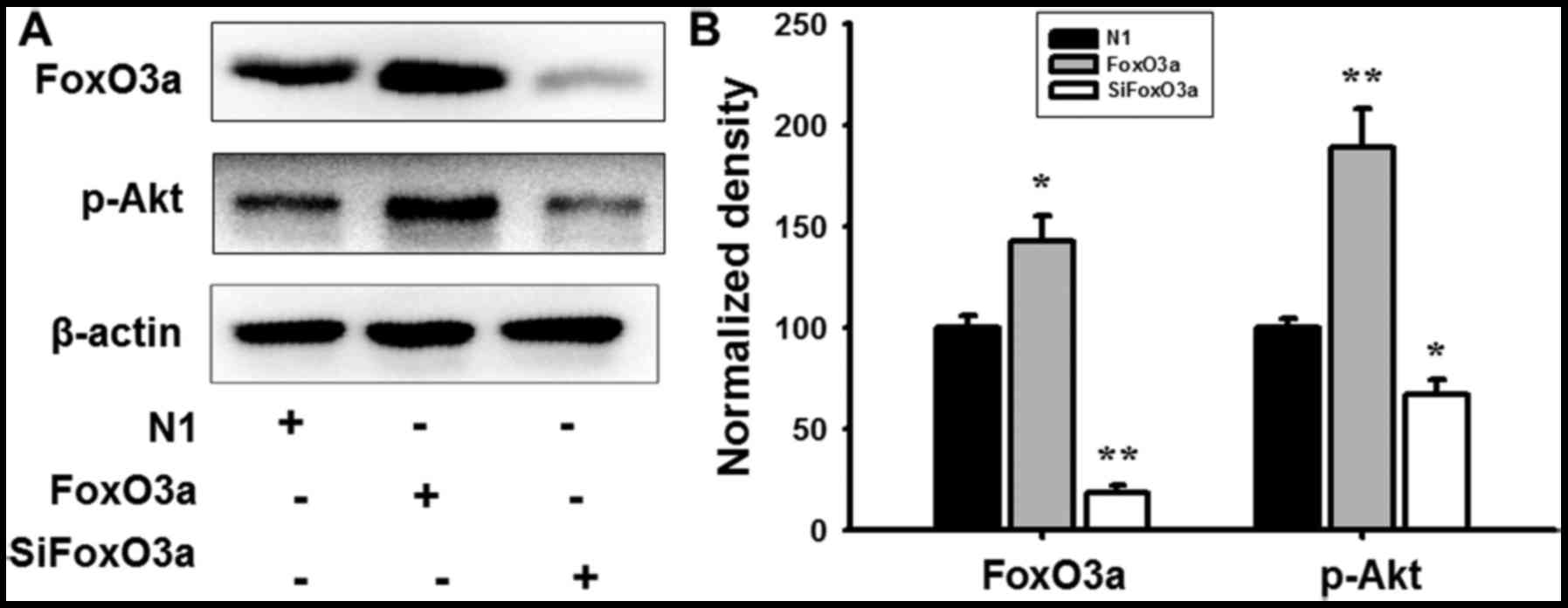Forkhead box protein O3 suppresses uveal melanoma development by increasing the expression of Bcl‑2‑like protein 11 and cyclin‑dependent kinase inhibitor 1B
- Authors:
- Published online on: December 7, 2017 https://doi.org/10.3892/mmr.2017.8215
- Pages: 3109-3114
Abstract
Introduction
Uveal melanoma (UM) is one of the most common malignant tumors in the adult eye (1). The treatments for UM are chemotherapy, radiotherapy and surgical resection (2). Despite the development of treatments, UM exhibits a high mortality rate (3). A number of studies have investigated the molecular mechanisms associated with the development and progression of UM, with the aim of developing more effective treatments for the disease (4).
Forkhead box O (FoxO) proteins are important for the regulation of cell proliferation, differentiation, DNA damage repair and autophagy (5,6). Forkhead box protein O3 (FoxO3a), a transcription factor which is an important member of the FoxO protein family, has been reported to be associated with numerous diseases, including prostate cancer, breast cancer and leukemia (7–9). The subcellular localization and transcriptional activity of FoxO3a is regulated by a number of post-translational modifications, including acetylation, ubiquitination and, particularly, phosphorylation (10,11). In response to growth and survival factors, including insulin like growth factor I (IGF-1), Rac-α serine/threonine protein kinase (Akt) is able to directly phosphorylate FoxO3a transcription factors in three different phosphorylation sites and induce their translocation from the nucleus to the cytoplasm, where FoxO3a transcription factors may be degraded and inhibit cellular regulatory functions (12). By contrast, in conditions of oxidative stress, Akt inactivation leads to FoxO3a protein dephosphorylation (activation), and FoxO3a may promote the expression of target genes, including Bcl-2-like protein 11 (Bim), cyclin-dependent kinase inhibitor 1 and cyclin-dependent kinase inhibitor 1B (p27Kip1), and may be associated with cell-cycle arrest and apoptosis (13–16). Therefore, the FoxO3a family has been demonstrated to be associated with various types of cancer. However, the effect of FoxO3a in the development and formation of UM remains unclear.
Previous preliminary data (17) has demonstrated that the FoxO3a transcription factor is associated with IGF-1-induced migration and invasion of UM cells. Therefore, the present study investigated the role of FoxO3a in the progression of UM. In the present study, UM cells with FoxO3a overexpression or knockdown were used to investigate the roles of FoxO3a in the development of UM. The results of the present study demonstrated that FoxO3a inhibited cell proliferation, induced apoptosis and led to G1 cell cycle phase accumulation in UM cells. In addition, FoxO3a increased the transcriptional activity and expression of Bim and p27Kip1, and inhibited the expression of cyclin D1, while FoxO3a knockdown exhibited the opposite effects. The data from the present study indicated that FoxO3a serves an important role in the cellular processes associated with UM, and that it may be a potential target for further investigation into the treatment of UM.
Materials and methods
Materials
All cell culture reagents and Lipofectamine® 3000 reagent were purchased from Invitrogen; Control N1-plasmid, FoxO3a-plasmid and small interfering (si)FoxO3a-plasmid were from Promega Corporation (Madison, WI, USA). MTT, dimethyl sulfoxide (DMSO), a Cell Cycle kit, and Annexin V-fluorescein isothiocyanate (FITC)/propidium iodide (PI) and bicinchoninic acid (BCA) assay kits were from obtained from Sigma-Aldrich (Merck KGaA, Darmstadt, Germany). Antibodies against phosphorylated (p)-Akt (cat. no. 4060) and FoxO3a (cat. no. 2497) were from Cell Signaling Technology, Inc. (Danvers, MA, USA). Anti-Bim (cat. no. C04455H), anti-p27Kip1 (cat. no. 12430), anti-Cyclin D1 (cat. no. C00353H) and anti-β-actin (cat. no. C08432H) were from Signalway Antibody LLC (College Park, MA, USA). The PrimeScript RT reagent kit and SYBR Green Real-Time PCR kit were obtained from Roche Diagnostics (Basel, Switzerland).
Cell culture and Lipofectamine transfection
Human UM cells were purchased from Shanghai Bioleaf Biotech Co., Ltd. (Shanghai, China). Cells were cultured in Dulbecco's modified Eagle's medium supplemented with 10% fetal bovine serum (FBS; Invitrogen; Thermo Fisher Scientific, Inc., Waltham, MA, USA) and 1% penicillin-streptomycin, at 37°C in a humidified atmosphere containing 5% CO2. When grown to 40% confluency, the UM cells were transfected with N1, FoxO3a and siFoxO3a (5 µg) using 7.5 µl Lipofectamine® 3000 reagent, according to the manufacturer's protocol. A total of 6 h following transfection, the culture medium was changed and cells were incubated for 36 h. The transfected UM cells were used for MTT, cell cycle and cellular apoptosis assays, western blotting and the reverse transcription-quantitative polymerase chain reaction (RT-qPCR).
Cell viability assay
Cells (1–2×105/well) were seeded into 96-well plates, followed by overnight incubation, and were transfected with the different plasmids. The transfected UM cells were selected using puromycin to generate stable cell lines. Briefly, prior to puromycin selection, the working concentration of puromycin for UM cells was determined using a series of concentrations ranging from 1 to 10 µg/ml. The lowest concentration that induced cell death in 100% of non-transfection UM cells in 3–4 days from the start of puromycin selection was chosen as the optimal concentration for the subsequent experiments. Following 48 h after transfection, UM cells were trypsinized, split into 10-cm culture dishes (200–500 cells/dish) and cultured in DMEM containing 10% FBS (Invitrogen; Thermo Fisher Scientific, Inc.) and 3 µg/ml puromycin (Sigma-Aldrich; Merck KGaA. During the selection period, the medium containing puromycin was exchanged every 2 days for ~3 weeks. Puromycin resistant cell colonies were manually picked, subcloned and passaged. UM cells at passages 3–5 were used for these experiments. The media was removed and replaced with fresh medium containing MTT (1 mg/ml), and the cells were incubated at 37°C for 4 h. The formazan crystals were dissolved by adding 100 µl DMSO and the absorbance was measured at 570 nm using a Bio-Rad 680 plate reader (Bio-Rad Laboratories, Inc., Hercules, CA, USA). The experiment was performed in triplicate.
Cell cycle assay
The transfected UM cells (2–3×104) were collected, washed twice with ice-cold PBS and fixed with 70% ethanol overnight at 4°C. The cells were incubated with 20 µg/ml RNase and stained with 20 µg/ml PI for 30 min at 4°C in the dark. Cell cycle distribution was analyzed by flow cytometry (EPICS XL Flow Cytometer; Beckman Coulter, Inc., Brea, CA, USA) using Flowjo software (version 7.6.1; Tree Star, Inc., Ashland, OR, USA). All experiments were repeated 3 times.
Cellular apoptosis assay
UM cells (5×105 per well) were seeded into 6-well plates. Following transfection for 36 h, the adherent and floating cells were harvested and washed twice with ice-cold PBS, and resuspended with Annexin V binding buffer. The cell supernatant was stained at room temperature with 5 µl Annexin V-FITC and 15 µl PI. The number of apoptotic cells was analyzed using flow cytometry (as described in the Cell cycle assay section). Each experiment was repeated three times.
Western blotting
A total of 36 h post-transfection, UM cells were collected and lysed with radioimmunoprecipitation assay lysis buffer [20 mM Tris (pH 7.5), 150 mM NaCl, 1 mM EDTA, 1 mM EGTA, 1% Triton X-100, 2.5 mM sodium pyrophosphate, 1 mM b-glycerophosphate, 1 mM Na3VO4, 1 mg/ml leupeptin and 1 mM PMSF]. Protein concentration was determined using a BCA Protein Assay kit (Sigma-Aldrich; Merck KGaA). Total proteins (30 µg/sample) were separated by 10% SDS-PAGE and transferred onto a polyvinylidene fluoride membrane. The membrane was subsequently blocked in 5% non-fat milk and incubated overnight at 4°C with primary antibodies (anti-p-Akt, FoxO3a, cyclin D1, p27Kip1, Bim and β-actin; 1:1,000). Following washing, blots were further incubated with the corresponding horseradish peroxidase-conjugated secondary antibody (cat. no. SA00001-1; ProteinTech Group, Inc., Chicago, IL, USA; 1:10,000) at room temperature for 1 h. and visualized with a chemiluminescence system (ChemiDoc Touch; Bio-Rad Laboratories, Inc.). Image J v 1.48 software (National Institutes of Health, Bethesda, MA, USA) was used to quantify optical density.
RT-qPCR analysis
Total RNA from transfected UM cells was isolated using TRIzol reagent (cat. no. QXT94240; Sigma; Merck KGaA) and cDNA was synthesized from total RNA (500 ng) using the Roche First Stand cDNA Synthesis kit (Roche Diagnostics). In order to detect the relative gene expression levels, a SYBR Green Real-Time PCR kit was used. The thermocycling conditions used for PCR were as follows: 95°C for 3 min, followed by 40 cycles of 95°C for 30 sec, Ta (data available on request) for 30 sec and 72°C for 30 sec. The data were analyzed using the comparative 2−ΔΔCq method (18). The primers were as follows: 60S ribosomal protein PL19 forward, 5′-GAGACAAAGTGGGAGCCAGCGA-3′ and reverse, 5′-ACCCTCCAGGAAGCGAGAATGC-3′; FoxO3a forward, 5′-CTCCCTACGCCAGTCTCCCAT-3′ and reverse, 5′-TGAGTCCGAAGTGAGCAGGTCC-3′; Bim forward, 5′-ATAAGCTAAAGAGGCTGAAAGAG-3′ and reverse, 5′-GAATGAAATGAGTCCCCAAAAC-3′; p27Kip1 forward, 5′-AAAAGCAACAGAAACCTATCCTCAC-3′ and reverse, 5′-ATTCAAAACTCCCAAGCACCTC-3′; and Cyclin D1 forward, 5′- CCC TCG GTG TCC TAC TTC AAA TGT-3′ and reverse, 5′-GGAAGCGGTCCAGGTAGTTCAT-3′.
Statistical analysis
The results of the present study were analyzed using SPSS software (version 19.0; IBM Corp., Armonk, NY, USA). All data are expressed as the mean ± standard error, and were evaluated using one-way analysis of variance followed by Tukey's post hoc test for multiple comparisons or a two-sided t-test. P<0.05 was considered to indicate a statistically significant difference.
Results
FoxO3a activity affects UM cell viability
In order to observe whether or not FoxO3a activity is associated with UM cell growth, the N1 control vector, FoxO3a and siFoxO3a were transfected into UM cells. Following the establishment of stable cell lines, cell number equivalent was detected using the MTT assay. Compared with N1 group, cell viability was decreased in FoxO3a group, while the viability of siFoxO3a group was markedly increased (Fig. 1). These data indicated that the FoxO3a activity inhibits UM cell growth.
FoxO3a activity affects UM cell cycle distribution
The present study investigated the association between FoxO3a activity and cell cycle distribution. UM cells were transfected with N1, FoxO3a and siFoxO3a, and the cell cycle distribution of UM cells was determined using flow cytometry. For the FoxO3a group, the proportion of UM cells at the G0/G1 phase increased, while cells at the S and G2/M phases decreased. By contrast, in the siFoxO3a group of UM cells, the cells were arrested in G0/G1 phase, and the number of cells at the S and G2/M phases decreased (Fig. 2).
FoxO3a activity promotes UM cell apoptosis
In order to examine the effect of FoxO3a on apoptosis in UM cells, the cells were transfected with N1 or FoxO3a and double-stained with Annexin V-FITC/PI. Cellular apoptosis was analyzed using flow cytometry. The apoptosis levels in UM cells transfected with FoxO3a were significantly increased compared with those in cells transfected with N1 (Fig. 3).
FoxO3a regulates the activity of its downstream targets
In order to further investigate the regulatory mechanism of FoxO3a in UM cells, mRNA expression and protein levels were detected using RT-qPCR analysis and western blotting. FoxO3a overexpression promoted the phosphorylation of Akt (Fig. 4), and markedly increased the mRNA and protein expression of Bim and p27Kip1; however, the cyclin D1 transcription and expression levels were decreased in UM cells compared with N1 (Fig. 5). When cells were transfected with siFoxO3a, the opposite cellular effects were observed (Figs. 4 and 5). The results of the present study demonstrated that FoxO3a may regulate the activity of Bim and p27Kip1.
Discussion
FoxO transcription factors belong to the large forkhead box family of proteins, consisting of FoxO1, FoxO3a, FoxO4 and FoxO6 in mammals (19). The FoxO transcription factors are well-known regulators of genes which are involved in important cellular processes, including cell cycle arrest, apoptosis, DNA repair and resistance to oxidative stress (20). FoxO3a is an important FoxO transcription factor and is associated with the formation and development of tumors. Previous studies have demonstrated a negative association between FoxO3a, and cancer grade and spread. In ovarian cancer, liver cancer, breast cancer and prostate cancer, FoxO3a expression is decreased (8,21–23). In addition, the nuclear transport and abnormal cytoplasmic distribution of FoxO3a is associated with poor prognosis of breast cancer (9). Upregulating FoxO3a expression inhibits the proliferation of breast cancer cells (24,25). Previous studies have demonstrated that IGF-1 is able to activate the phosphatidylinositol 3-kinase (PI3K)/Akt signaling pathway in UM cells, and the activated PI3K/Akt pathway has been demonstrated to promote the phosphorylation of FoxO3a (26). FoxO3a phosphorylation induces its translocation into the cytoplasm from the nucleus and inhibits its function. Therefore, the present study investigated whether FoxO3a activation may be a target for intervention and treatment for the development of UM, and whether there exists a negative feedback mechanism in the activation process.
The PI3K/Akt signaling pathway is an important pathway for tumor cell proliferation, differentiation and apoptosis, and FoxO3a is the principal downstream target of the kinase activity of Akt (27). Akt is able to phosphorylate FoxO3a and promote its interaction with 14-3-3 protein, which leads to nuclear exclusion and inhibits FoxO3a activity (28,29). When the PI3K/Akt pathway is inhibited by siRNA or the pharmacological antagonist LY294002, the phosphorylation of FoxO3a is decreased, and FoxO3a dephosphorylation is increased, in breast cells (30). FoxO3a dephosphorylation induces its accumulation in the nucleus and an increase in its activity; FoxO3a activity has been demonstrated to upregulate the expression of p27Kip1 and to inhibit cell proliferation (30). Due to the aforementioned previous results, FoxO3a overexpression or knockdown plasmids were constructed in the present study, in order to investigate the tumor suppressive effect and associated molecular mechanisms of FoxO3a in UM cells. The results demonstrated that FoxO3a overexpression inhibited cell proliferation, promoted cellular apoptosis and led to the accumulation of cells at the G1 cell cycle phase. Western blot analysis demonstrated that FoxO3a overexpression promoted Akt phosphorylation, increased the transcriptional activity and protein expression of Bim and p27Kip1, and inhibited cyclin D1 transcription and expression. The results of the present study demonstrated that the effects of FoxO3a on the cell cycle and apoptosis may be regulated by the transcription and expression of Bim, p27Kip1 and cyclin D1.
In conclusion, the results of the present study demonstrated that FoxO3a activity affects the proliferation, apoptosis and cell cycle of UM cells, altering cell fate and impacting on tumor development. Therefore, FoxO3a may serve a role in the formation and development of UM, and it may represent a candidate target for the treatment of UM.
Acknowledgements
The present study was supported by the Guangdong Provincial Project of Science and Technology (grant no. 2011B050200005), the National Natural Science Foundation of China (grant no. 31371088), the University of Macau (grant nos. SRG2015-00004-FHS and MYRG2016-00052-FHS), and the Science and Technology Development Fund of Macau (grant no. FDCT 021/2015/A1).
References
|
Hu DN, Yu GP, McCormick SA, Schneider S and Finger PT: Population-based incidence of uveal melanoma in various races and ethnic groups. Am J Ophthalmol. 140:612–617. 2005. View Article : Google Scholar : PubMed/NCBI | |
|
Damato B and Heimann H: Personalized treatment of uveal melanoma. Eye (Lond). 27:172–179. 2013. View Article : Google Scholar : PubMed/NCBI | |
|
Liu YC, Tsai CC, Lee FL, Lee SM and Kao SC: Mortality from uveal melanoma treated by enucleation -a 16-year survey in Taiwan. Acta Ophthalmol. 91:e583–e584. 2013. View Article : Google Scholar : PubMed/NCBI | |
|
Shoushtari AN and Carvajal RD: Treatment of uveal melanoma. Cancer Treat Res. 167:281–293. 2016. View Article : Google Scholar : PubMed/NCBI | |
|
Zhang X, Tang N, Hadden T and Rishi A: Akt, FoxO and regulation of apoptosis. Biochim Biophys Acta. 1813:1978–1986. 2011. View Article : Google Scholar : PubMed/NCBI | |
|
Wang H, Quirion R, Little PJ, Cheng Y, Feng ZP, Sun HS, Xu JP and Zheng WH: Forkhead box O transcription factors as possible mediators in the development of major depression. Neuropharmacology. 99:527–537. 2015. View Article : Google Scholar : PubMed/NCBI | |
|
Zhu H: Targeting forkhead box transcription factors FOXM1 and FOXO in leukemia (Review). Oncol Rep. 32:1327–1334. 2014. View Article : Google Scholar : PubMed/NCBI | |
|
Shukla S, Shukla M, MacLennan GT, Fu P and Gupta S: Deregulation of FOXO3A during prostate cancer progression. Int J Oncol. 34:1613–1620. 2009.PubMed/NCBI | |
|
Fonseca EAI, Oliveira MA, Eichler R, Akamine EH, Carvalho MHC, Barbosa AM, Dekker RFH, Khaper N and Fortes ZB: Antitumor effect of metformin in breast cancer is associated with AMPK and FOXO3a activation. Cancer Res. 73:2013. View Article : Google Scholar | |
|
Obsil T and Obsilova V: Structure/function relationships underlying regulation of FOXO transcription factors. Oncogene. 27:2263–2275. 2008. View Article : Google Scholar : PubMed/NCBI | |
|
Vogt PK, Jiang H and Aoki M: Triple layer control: Phosphorylation, acetylation and ubiquitination of FOXO proteins. Cell Cycle. 4:908–913. 2005. View Article : Google Scholar : PubMed/NCBI | |
|
Wang H, Zhou X, Huang J, Mu N, Guo Z, Wen Q, Wang R, Chen S, Feng ZP and Zheng W: The role of Akt/FoxO3a in the protective effect of venlafaxine against corticosterone-induced cell death in PC12 cells. Psychopharmacology (Berl). 228:129–141. 2013. View Article : Google Scholar : PubMed/NCBI | |
|
Biggs WH, Meisenhelder J, Hunter T, Cavenee WK and Arden KC: Protein kinase B/Akt-mediated phosphorylation promotes nuclear exclusion of the winged helix transcription factor FKHR1. P Natl Acad Sci USA. 96:7421–7426. 1999. View Article : Google Scholar | |
|
Brunet A, Bonni A, Zigmond MJ, Lin MZ, Juo P, Hu LS, Anderson MJ, Arden KC, Blenis J and Greenberg ME: Akt promotes cell survival by phosphorylating and inhibiting a forkhead transcription factor. Cell. 96:857–868. 1999. View Article : Google Scholar : PubMed/NCBI | |
|
Tang ED, Nuñez G, Barr FG and Guan KL: Negative regulation of the forkhead transcription factor FKHR by Akt. J Biol Chem. 274:16741–16746. 1999. View Article : Google Scholar : PubMed/NCBI | |
|
Cui M, Huang Y, Zhao Y and Zheng J: Transcription factor FOXO3a mediates apoptosis in HIV-1-infected macrophages. J Immunol. 180:898–906. 2008. View Article : Google Scholar : PubMed/NCBI | |
|
Yan F, Liao R, Farhan M, Wang T, Chen J, Wang Z, Little PJ and Zheng W: Elucidating the role of the FoxO3a transcription factor in the IGF-1-induced migration and invasion of uveal melanoma cancer cells. Biomed Pharmacother. 84:1538–1550. 2016. View Article : Google Scholar : PubMed/NCBI | |
|
Livak KJ and Schmittgen TD: analysis of relative gene expression data using real-time quantitative PCR and the 2(-Delta Delta C(T)) method. Methods. 25:402–408. 2001. View Article : Google Scholar : PubMed/NCBI | |
|
Paik JH, Kollipara R, Chu G, Ji H, Xiao Y, Ding Z, Miao L, Tothova Z, Horner JW, Carrasco DR, et al: FoxOs are lineage-restricted redundant tumor suppressors and regulate endothelial cell homeostasis. Cell. 128:309–323. 2007. View Article : Google Scholar : PubMed/NCBI | |
|
Burgering BM and Kops GJ: Cell cycle and death control: Long live Forkheads. Trends Biochem Sci. 27:352–360. 2002. View Article : Google Scholar : PubMed/NCBI | |
|
Ning Y, Luo C, Ren K, Quan M and Cao J: FOXO3a-mediated suppression of the self-renewal capacity of sphere-forming cells derived from the ovarian cancer SKOV3 cell line by 7-difluoromethoxy1-5,4′-di-n-octyl genistein. Mol Med Rep. 9:1982–1988. 2014. View Article : Google Scholar : PubMed/NCBI | |
|
He LY, Wei X, Du L, Liu L, Xu F, Min J, Li C, Tao DD, Chen Q, Hu JB and Gong JP: Remarkably reduced expression of FoxO3a in metaplastic colorectum, primary colorectal cancer and liver metastasis. J Huazhong Univ Sci Technolog Med Sci. 33:205–211. 2013. View Article : Google Scholar : PubMed/NCBI | |
|
Lin CH, Chang CY, Lee KR, Lin HJ, Chen TH and Wan L: Flavones inhibit breast cancer proliferation through the Akt/FOXO3a signaling pathway. BMC Cancer. 15:9582015. View Article : Google Scholar : PubMed/NCBI | |
|
Yang JY, Zong CS, Xia W, Yamaguchi H, Ding Q, Xie X, Lang JY, Lai CC, Chang CJ, Huang WC, et al: ERK promotes tumorigenesis by inhibiting FOXO3a via MDM2-mediated degradation. Nat Cell Biol. 10:138–148. 2008. View Article : Google Scholar : PubMed/NCBI | |
|
Yang WS, Dolloff NG and El-Deiry WS: ERK and MDM2 prey on FOXO3a. Nat Cell Biol. 10:125–126. 2008. View Article : Google Scholar : PubMed/NCBI | |
|
Wang H, Zhang Q, Zhang L, Little PJ, Xie X, Meng Q, Ren Y, Zhou L, Gao G, Quirion R and Zheng W: Insulin-like growth factor-1 induces the phosphorylation of PRAS40 via the PI3K/Akt signaling pathway in PC12 cells. Neurosci Lett. 516:105–109. 2012. View Article : Google Scholar : PubMed/NCBI | |
|
Zhang K, Moran A, Holst J and Wang Q: PI3K/Akt signalling regulates leucine transport in prostate cancer. Bju Int. 116:34–35. 2015. | |
|
Matsuzaki H, Daitoku H, Hatta M, Tanaka K and Fukamizu A: Insulin-induced phosphorylation of FKHR (Foxo1) targets to proteasomal degradation. Proc Natl Acad Sci USA. 100:pp. 11285–11290. 2003; View Article : Google Scholar : PubMed/NCBI | |
|
Wen Q, Duan X, Liao R, Little P, Gao G, Jiang H, Lalit S, Quirion R and Zheng W: Characterization of intracellular translocation of Forkhead transcription factor O (FoxO) members induced by NGF in PC12 cells. Neurosci Lett. 498:31–36. 2011. View Article : Google Scholar : PubMed/NCBI | |
|
Myatt SS and Lam EW: The emerging roles of forkhead box (Fox) proteins in cancer. Nat Rev Cancer. 7:847–859. 2007. View Article : Google Scholar : PubMed/NCBI |














